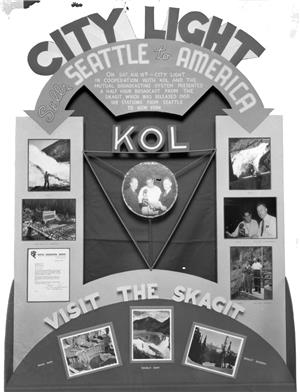On August 19, 1939, at 5:00 p.m., Seattle radio station KOL broadcasts The Romance of Power coast-to-coast, live from Seattle City Light's Skagit River hydro-electric project. The half-hour program, which features interviews with City Light managers, dramatizes hydro-electric power and the awe-inspiring surroundings of the dam. The production is designed by the Mutual Broadcasting System as a memorial to Seattle City Light Superintendent James Delmage ("J.D.") Ross (1872-1939) who had died a few months earlier. The script for the show reveals details of producing a radio show from a remote natural setting and the obstacles to be overcome in a time before microwaves and satellite cameras.
Difficult and Trying Conditions
The Studio Announcer began the show by explaining,
"For weeks radio engineers have been preparing for this broadcast under difficult and trying conditions to bring you a word picture of POWER, [emphasis in original] and the romance of its making. WE LEAVE THE TRAVELED AIRWAYS OF RADIO.. WE TAKE OUR MICROPHONES TO THE WILDERNESS.. WE BRING YOU THE MAGNETIC, SEETHING, VIBRANT STORY OF POWER RIGHT FROM ITS CRADLE IN THE SKAGIT RIVER GORGE.. Are you ready at the Gorge? .. THEN.. COME IN - DUDLEY WILLIAMSON."
Announcer Dudley Williamson began the remote portion of the show on the Skagit River from Gorge Power House. He described the location with elaborate language:
"...though man has laid a bridle on the majesty and power of the mighty waters, the forests and the granite hillsides still belong to Nature. It's true that we stand in the heart of the home state of more than one and one-half million persons; it's true that only 128 miles away a teeming metropolis sprawls on the shores of the huge bowl of the Puget Sound.. but, we, right now, for this moment, are in the age of creation."
Generators Heard Coast to Coast
After allowing listeners to hear the generators of the Gorge Power House, Williamson tosses to Wheeler Smith and Frank Anderson at Diablo Dam. Here the script notes, "Must be two mikes and each must be portable ... with at least 100 feet of wire."
Wheeler opened this segment with:
"Measured by your clock, you are just a split second away from the original point of this broadcast. Measured in river miles, you are now seven miles higher into the Skagit Canyon."
Smith was at the top of Diablo Dam and Anderson was 310 feet below at the bottom of the spillway. Each held a microphone and gave listeners the roar of the water flowing over the spillway. All communication was by wire strung between the announcers, and the link with Seattle was also by wire. The script gives these directions: "Mike will have to be lowered over side of dam or at least carried close enough to pick up roar of water. Since it takes about 8 minutes to open one of the spillways, it's essential that the foregoing dialogue take place where the sound of the water can't be heard..."
Water White With Rage
Smith painted a word picture of the water below the dam:
"The water as it comes through the spillway is in a mad frenzy that seems uncontrollable. It's literally white with rage. Then, only a few feet beyond the bottom of the fall, the river bends quickly and before it starts down the Canyon to Gorge, the Skagit rests itself for a moment in a quiet pool. And when I turn my light on the pool I can see the indescribable beauty of the color of this water. It's neither blue nor green, but the most clearly liquid color I've ever seen. I notice now that the foam of the rushing water is tinged with this same aquamarine tone, that becomes fainter and fainter as I turn my light toward the base of the dam."
The program then shifted upstream to Ross Dam to announcer Edward Jansen and his guest, Glen Smith, Chief Engineer of the Skagit Project. Smith recounted his first exploration of the Skagit with City Light Superintendent "J.D." Ross. He used various comparisons to explain how much power would be produced by the three City Light dams on the Skagit. For example:
"...we'll put a fifty-watt globe on every one of the 24 million front porches in America.. and with those 2½ billion kilowatt hours we can turn on every one of those 24 million porch lights at sundown.. and leave them burning til past midnight every night for a whole year."
Night-time Witchery
The broadcast returned to Dudley Williamson down at the Gorge who introduced Eugene R. Hoffman, Superintendent of Seattle City Light. Hoffman outlined J.D. Ross's dream of providing Seattle with "cheap, plentiful electricity." Williamson closed his broadcast with:
"And now, just as the last rays of the sun are setting, and the dusk of the Western day turns into darkness, the hillside is alight with colored illuminations designed by Mr. Ross to enhance this beauty spot... The grey moss-covered boulders that line the water's fall take on a night-time witchery that Nature could only hint at, as streamers of softly-lighted spray drift across the hillsides. And over the hush of the night [music — 'God Bless America' — from a loudspeaker sounds in background] soft music calls from the hillsides, as a melodic echo of the beauty that has become an integral part of the Skagit River Project.

